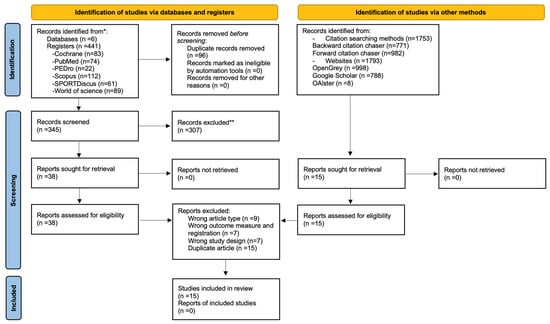Journal Description
Journal of Functional Morphology and Kinesiology
Journal of Functional Morphology and Kinesiology
is a peer-reviewed, open access journal on functional morphology and kinesiology research dealing with the analysis of structure, function, development, and evolution of cells and tissues of the musculoskeletal system and the whole body related to the movement exercise-based approach, published quarterly online by MDPI.
- Open Access— free for readers, with article processing charges (APC) paid by authors or their institutions.
- High Visibility: indexed within ESCI (Web of Science), Scopus, PubMed, PMC, FSTA, and other databases.
- Journal Rank: JCR - Q2 (Sport Sciences) / CiteScore - Q2 (Physical Therapy, Sports Therapy and Rehabilitation)
- Rapid Publication: manuscripts are peer-reviewed and a first decision is provided to authors approximately 26.9 days after submission; acceptance to publication is undertaken in 1.9 days (median values for papers published in this journal in the first half of 2025).
- Recognition of Reviewers: reviewers who provide timely, thorough peer-review reports receive vouchers entitling them to a discount on the APC of their next publication in any MDPI journal, in appreciation of the work done.
Impact Factor:
2.5 (2024)
Latest Articles
Blood Flow Restriction Training Prior to and After Anterior Cruciate Ligament Reconstruction: A Scoping Review
J. Funct. Morphol. Kinesiol. 2025, 10(4), 450; https://doi.org/10.3390/jfmk10040450 - 19 Nov 2025
Abstract
Background: Anterior cruciate ligament injuries often lead to muscle atrophy and prolonged recovery following anterior cruciate ligament reconstruction (ACLR). Blood flow restriction (BFR) has emerged as a strategy to optimize neuromuscular adaptations with lower loads, potentially enhancing rehabilitation outcomes in both preoperative
[...] Read more.
Background: Anterior cruciate ligament injuries often lead to muscle atrophy and prolonged recovery following anterior cruciate ligament reconstruction (ACLR). Blood flow restriction (BFR) has emerged as a strategy to optimize neuromuscular adaptations with lower loads, potentially enhancing rehabilitation outcomes in both preoperative and postoperative phases. This review aims to comprehensively evaluate the comparative effectiveness of BFR applied during resistance and endurance exercises versus non-BFR protocols, both before and after ACLR, while also examining key training parameters and BFR protocols to guide further research and clinical practice. Methods: A comprehensive literature search was conducted across multiple databases, including WoS, PEDro, Scopus, PUBMED (MEDLINE), SportDiscus, and the Cochrane Library, covering publications from inception to 24 September 2025. Studies eligible for inclusion were randomized controlled trials and quasi-randomized controlled trials that compared BFR interventions with non-BFR training in patients undergoing ACLR. Data synthesis followed the recommendations of the PRISMA Extension for Scoping Reviews (PRISMA-ScR). The PEDro and CERT scales were used to assess the methodological quality of the included studies. Detailed training parameters and cuff specifications were extracted and are summarized in tables. Results: In total, 15 of the initial 441 articles identified met the eligibility criteria and were included in the final analysis, comprising a sample of 417 patients. Outcomes were categorized into six areas: body composition, neuromuscular responses and adaptations, self-report questionnaires, functional measures, muscle physiology and biomarkers, and return to activity. Five articles focused on preoperative interventions, nine focused on postoperative interventions, and one addressed both phases. Conclusions: This review suggests that BFR resistance training is an effective tool in the preoperative and postoperative phases of ACLR. Additionally, it can help improve muscle size, strength, functional measurements, body composition, muscle blood flow, and subjective perceptions.
Full article
(This article belongs to the Section Sports Medicine and Nutrition)
►
Show Figures
Open AccessArticle
Relationship Between Physical Fitness Index and Body Mass Index: A Cross-Sectional Study in Serbian Students of Biomedical Sciences
by
Aldina Ajdinović, Elvis Mahmutović, Emir Biševac, Zerina Salihagić, Teodora Safiye, Oliver Radenković, Ilma Čaprić, Raid Mekić, Slaviša Minić, Dejan Aleksić, Mina Lilić and Saša Bubanj
J. Funct. Morphol. Kinesiol. 2025, 10(4), 449; https://doi.org/10.3390/jfmk10040449 - 19 Nov 2025
Abstract
Objectives: Physical fitness is vital to sustaining the health of each individual and represents the level of readiness that allows them to perform everyday activities with sufficient energy. The aim of this research was to assess the physical fitness index and to determine
[...] Read more.
Objectives: Physical fitness is vital to sustaining the health of each individual and represents the level of readiness that allows them to perform everyday activities with sufficient energy. The aim of this research was to assess the physical fitness index and to determine its relationship with body composition. Methods: This research included 121 students of the State University of Novi Pazar, Serbia. The modified Harvard step test was used to assess physical fitness, and the body mass index was used to assess body composition. Results: Statistical analysis indicated that the physical fitness of students was not significantly satisfactory, given the large percentage of students with low-average and poor levels of physical fitness. A strong negative correlation between physical fitness index and body mass index was shown by Pearson (−0.720) and Spearman (−0.659) correlation coefficients with a p-value < 0.001. The results of the chi-square test (χ2(3) = 88.94, p < 0.001) also confirm this correlation. Conclusions: This study indicates widespread poor physical fitness among students and highlights the importance of regular exercise as a key factor for improving physical abilities. Given the relatively high prevalence of suboptimal prevalence of suboptimal physical fitness among university students, our findings represent a critical wake-up call for public health authorities, underscoring the urgent need for targeted interventions to reverse this trend and safeguard the health potential of the next generation.
Full article
(This article belongs to the Section Physical Exercise for Health Promotion)
►▼
Show Figures
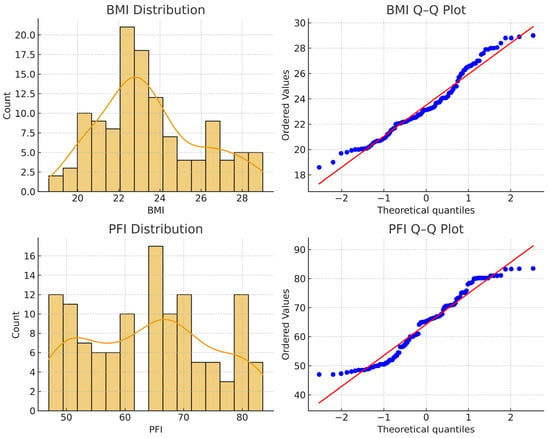
Figure 1
Open AccessArticle
Test–Retest Reliability and Sex-Dependent Responses for Physiological and Perceptual Variables at Sub-Maximal Thresholds
by
Erik R. Snell, Pasquale J. Succi, Clara J. Mitchinson, Brian Benitez, Minyoung Kwak, Alaina N. Kuhn and Haley C. Bergstrom
J. Funct. Morphol. Kinesiol. 2025, 10(4), 448; https://doi.org/10.3390/jfmk10040448 - 19 Nov 2025
Abstract
Background: Fatigue thresholds such as the gas exchange threshold (GET) and respiratory compensation point (RCP) describe unique physiological responses. This study investigated the reliability of, and sex-dependent responses for, the GET and RCP across absolute, relative, and normalized expressions of volume of oxygen
[...] Read more.
Background: Fatigue thresholds such as the gas exchange threshold (GET) and respiratory compensation point (RCP) describe unique physiological responses. This study investigated the reliability of, and sex-dependent responses for, the GET and RCP across absolute, relative, and normalized expressions of volume of oxygen consumption (
(This article belongs to the Section Physical Exercise for Health Promotion)
Open AccessArticle
Field Position-Related Variations in Body Mass, Postural Control, and Isokinetic Strength in Portuguese Professional Football
by
João Rocha, Hélder Cruz, José Eduardo Teixeira, Carolina Vila-Chã, Raúl Filipe Bartolomeu, João Nuno Ribeiro, Faber Martins and Pedro Tiago Esteves
J. Funct. Morphol. Kinesiol. 2025, 10(4), 447; https://doi.org/10.3390/jfmk10040447 - 19 Nov 2025
Abstract
Background: Combining body composition, dynamic postural control, and isokinetic strength allows for a comprehensive physical and functional assessment of football players across specific playing positions. The aim of this study was to analyze the field position-related variations in the physical and functional
[...] Read more.
Background: Combining body composition, dynamic postural control, and isokinetic strength allows for a comprehensive physical and functional assessment of football players across specific playing positions. The aim of this study was to analyze the field position-related variations in the physical and functional profiles of male football players. Methods: A convenience sample of 23 professional male football players from a Portuguese second league team, aged 18 to 32 years (23.83 ± 3.77 years), participated in the present study. Players from five field positions (central backs, central midfielders, wide midfielders, and forwards) were assessed for body composition, dynamic postural control, and isokinetic lower limb strength. Body composition was assessed by bioelectrical impedance; composite scores for postural control in the right and left limbs were obtained through the Y-Balance test lower quarter (YBT-LQ). Peak torque (PT) during lower limb flexion and extension was measured using an isokinetic dynamometer chair. Results: Significant differences were found only in peak torque of the right extensors [H (4) = 9.84, p = 0.043, η2 = 0.37)], whereas no significant differences emerged in body mass, dynamic balance scores, left-side extension and flexion, or hamstring-to-quadriceps (H:Q) strength ratios. Post hoc analysis using Mann–Whitney U tests with Holm correction did not confirm pairwise differences between positions. The correlation analysis revealed mainly moderate-to-strong associations between symmetrical measures (composite YBT-LQ right and left, PT extension right and left), as well as between anthropometric and strength variables, but without consistent position-specific patterns. Conclusions: Overall, the study provides valuable insights into the physical attributes of professional football players, highlighting the general similarity of profiles across positions and suggesting that individualized training approaches may still be beneficial to optimizing performance and reduce injury risk. Future studies should extend the analysis to larger cohorts across different professional Portuguese football teams and competitions.
Full article
(This article belongs to the Special Issue Integrative Perspectives on Functional Morphology, Performance and Injury Prevention in Soccer)
►▼
Show Figures
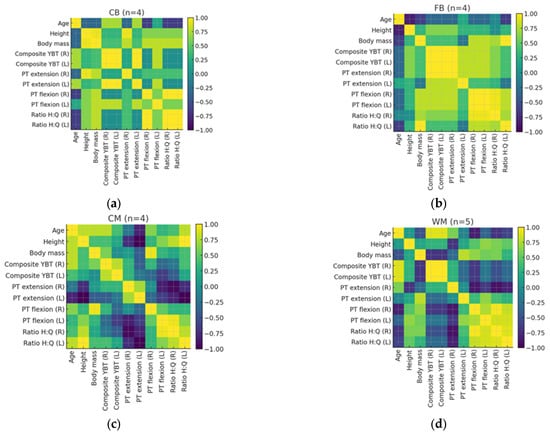
Figure 1
Open AccessArticle
Effects of Familiar Language Lyrics in Self-Selected Motivational Music on Sprint Performance and Psychophysiological Responses: An Exploratory Study
by
Shigeki Kasai and Daisuke Ando
J. Funct. Morphol. Kinesiol. 2025, 10(4), 446; https://doi.org/10.3390/jfmk10040446 - 18 Nov 2025
Abstract
Background: Listening to fast-tempo or motivational music before exercise may improve maximal pedaling performance, but the role of lyric comprehension remains unclear. This study tested whether self-selected music with familiar language lyrics perceived as motivational improves sprint performance and psychophysiological responses. Methods
[...] Read more.
Background: Listening to fast-tempo or motivational music before exercise may improve maximal pedaling performance, but the role of lyric comprehension remains unclear. This study tested whether self-selected music with familiar language lyrics perceived as motivational improves sprint performance and psychophysiological responses. Methods: Fourteen healthy young men (age: 19.7 ± 1.7 years; height: 171.2 ± 3.1 cm; weight: 65.8 ± 7.1 kg; body mass index: 22.4 ± 2.1 kg/m2) who exercised regularly (≥3 sessions/week) participated in a within-subject crossover design, completing a 20 s maximal pedaling test across 3 randomized conditions: control (Con; no music), music with unfamiliar language lyrics (UM), and self-selected music with familiar language lyrics (FM). All participants completed all three experimental conditions in a randomized order. Data were analyzed using repeated-measures ANOVA and paired t-tests (α = 0.05). Relative peak and mean power outputs were recorded. Motivation, arousal, and pleasant emotion were assessed at rest, after listening to music, after warm-up, and after exercise. Prefrontal hemodynamics and autonomic nervous system activity were recorded continuously. Results: Relative peak power was higher in FM (8.42 ± 0.61 W/kg) than Con (8.23 ± 0.58 W/kg; p < 0.01; d = 1.05); mean power did not differ across conditions. FM showed higher motivation and arousal after music compared with Con and UM, and higher pleasant emotion throughout. No significant differences across conditions were observed in prefrontal hemodynamics or autonomic nervous system activity. Conclusions: Listening to self-selected music with familiar language lyrics perceived as motivational during subsequent maximal pedaling enhanced peak power and psychological responses. Lyric comprehension and language familiarity likely play an important role in the ergogenic effects of music before high-intensity exercise.
Full article
(This article belongs to the Section Physical Exercise for Health Promotion)
►▼
Show Figures
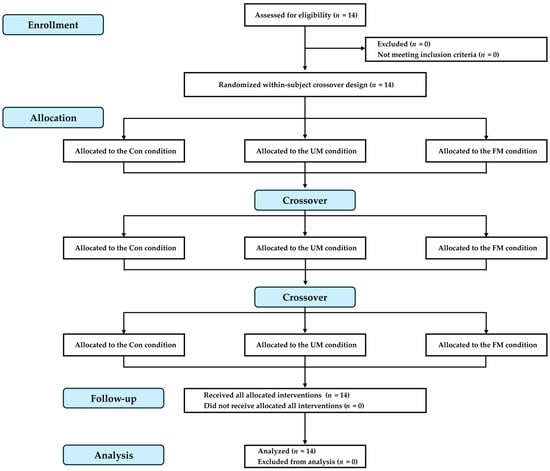
Figure 1
Open AccessArticle
Does the 10% Asymmetry Threshold Matter? Effects of Lower-Limb Asymmetries on Jumping and Agility in Basketball
by
Nóra Szabó, Tamás Atlasz, Márk Váczi and Balázs Sebesi
J. Funct. Morphol. Kinesiol. 2025, 10(4), 445; https://doi.org/10.3390/jfmk10040445 - 18 Nov 2025
Abstract
Background: Lower-limb asymmetry is linked to injury risk and may impair performance, yet evidence in basketball is inconsistent. A commonly cited 10% threshold is proposed as critical, but its practical relevance in basketball-specific tasks remains unclear. This study examined the effects of
[...] Read more.
Background: Lower-limb asymmetry is linked to injury risk and may impair performance, yet evidence in basketball is inconsistent. A commonly cited 10% threshold is proposed as critical, but its practical relevance in basketball-specific tasks remains unclear. This study examined the effects of asymmetry on vertical jump and agility performance in basketball players, with particular focus on the 10% threshold. Methods: Male university basketball players (n = 20) completed unilateral jump tests (single-leg countermovement jump, single-hop, triple-hop, 6 m hop) and a bilateral COD (change of direction) test to quantify asymmetry. Basketball-specific performance was evaluated using the Lane Agility Test and bilateral countermovement jump. Asymmetry indices were calculated as absolute percentage differences. Paired tests, Welch’s t-tests (<10% vs. ≥10% asymmetry), and Pearson correlations were applied. Results: Significant inter-limb asymmetries were detected across all unilateral tasks (large effect sizes). Players with ≥10% asymmetry showed reduced bilateral countermovement jump height compared to <10% (p = 0.039, d = 1.00). Triple-hop asymmetry correlated strongly with slower Lane Agility Test times (r = 0.62, p = 0.003), while single-leg jump asymmetry correlated moderately and negatively with bilateral countermovement jump height (r = −0.46, p = 0.043). No significant associations were found for COD asymmetry. Conclusions: In the present study, inter-limb asymmetries exceeding 10% were associated with impaired vertical jump performance. Triple-hop asymmetry appears most relevant for agility, whereas COD asymmetry may not adequately reflect basketball-specific demands. Monitoring and reducing inter-limb asymmetries may support both performance and injury prevention.
Full article
(This article belongs to the Special Issue Health and Performance Through Sports at All Ages: 4th Edition)
►▼
Show Figures
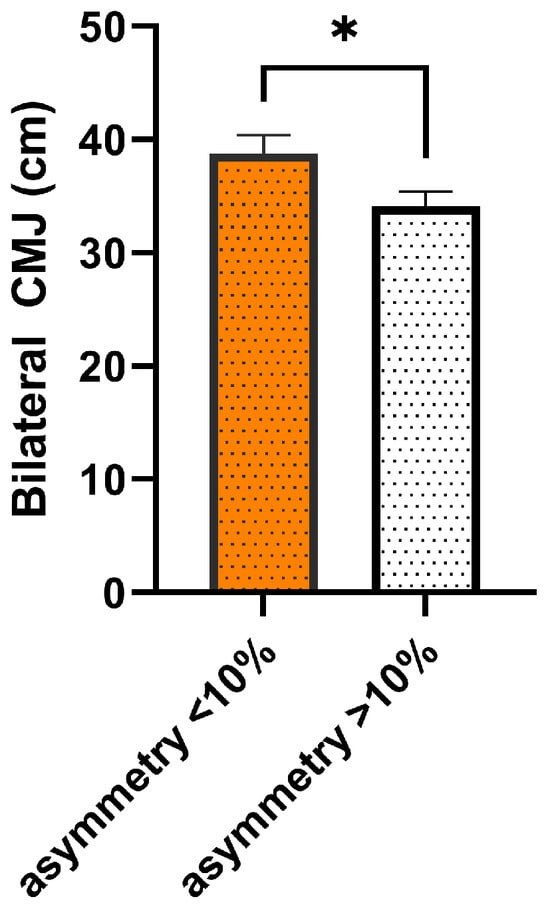
Figure 1
Open AccessArticle
Normobaric Hypoxic Cardiac Rehabilitation: Comparative Effects of Training at 2000 m and 3000 m Simulated Altitude in Post-Myocardial Infarction Patients
by
Agata Nowak-Lis, Tomasz Gabryś, Zbigniew Nowak, Anna Konarska-Rawluk, Dominika Grzybowska-Ganszczyk and Radosław Chruściński
J. Funct. Morphol. Kinesiol. 2025, 10(4), 444; https://doi.org/10.3390/jfmk10040444 - 18 Nov 2025
Abstract
Background: Coronary artery disease remains the leading cause of morbidity and mortality in developed countries. Despite advances in treatment and standard rehabilitation, conventional programs may be monotonous and insufficiently engaging. Normobaric hypoxia, simulating high-altitude conditions, has emerged as a potential method to enhance
[...] Read more.
Background: Coronary artery disease remains the leading cause of morbidity and mortality in developed countries. Despite advances in treatment and standard rehabilitation, conventional programs may be monotonous and insufficiently engaging. Normobaric hypoxia, simulating high-altitude conditions, has emerged as a potential method to enhance cardiovascular adaptations in post-myocardial infarction (MI) patients. Objective: This study aimed to compare the efficacy and safety of exercise-based cardiac rehabilitation performed under normobaric hypoxia corresponding to altitudes of 2000 m and 3000 m above sea level in patients after MI treated with percutaneous coronary intervention (PCI). Methods: A total of 61 male post-MI patients (mean age 60.4 ± 8.9 years) were randomized into two groups: training under simulated altitudes of 2000 m (n = 35) or 3000 m (n = 26). The 22-day program consisted of interval ergometer sessions. Pre- and post-intervention assessments included cardiopulmonary exercise testing (CPET), echocardiography, and tissue Doppler imaging (TDI). Results: Both groups demonstrated significant improvements in exercise tolerance. Training at 2000 m significantly increased test duration (r = 0.735) and peak heart rate (r = 0.467). At 3000 m, additional benefits were observed, including improvements in metabolic equivalent (r = 0.861), peak oxygen consumption (d = 0.81), and reduction in respiratory exchange ratio (r = 0.682). Intergroup analysis revealed moderate differences favoring the 3000 m group in MET, breathing frequency, and RER. Echocardiography showed beneficial remodeling in both groups, with improvements in LV dimensions, ejection fraction, and MAPSE. Notably, training at 2000 m resulted in more consistent echocardiographic benefits compared to 3000 m. Conclusions: Cardiac rehabilitation under normobaric hypoxia is effective and safe in stable post-MI patients. Training at 3000 m provides greater improvements in exercise tolerance, while 2000 m confers more favorable effects on cardiac structure and function. These findings suggest that moderate hypoxic exposure (2000 m) may represent an optimal balance between efficacy and safety in post-MI rehabilitation.
Full article
(This article belongs to the Special Issue Effects of Exercise Training on Cardiovascular Risks Factors in Primary and Secondary Prevention)
►▼
Show Figures

Figure 1
Open AccessArticle
The Effect of a 10-Week Electromyostimulation Intervention with the StimaWELL 120MTRS System on Multifidus Morphology and Function in Chronic Low Back Pain Patients: A Randomized Controlled Trial
by
Daniel Wolfe, Brent Rosenstein, Geoffrey Dover, Mathieu Boily and Maryse Fortin
J. Funct. Morphol. Kinesiol. 2025, 10(4), 443; https://doi.org/10.3390/jfmk10040443 - 18 Nov 2025
Abstract
Background: Chronic low back pain (CLBP) patients present with morphological and functional deficits to the lumbar multifidus. Electromyostimulation (EMS) can be used to improve activation and strength in atrophied skeletal muscle, but its effect on multifidus morphology and function in CLBP patients is
[...] Read more.
Background: Chronic low back pain (CLBP) patients present with morphological and functional deficits to the lumbar multifidus. Electromyostimulation (EMS) can be used to improve activation and strength in atrophied skeletal muscle, but its effect on multifidus morphology and function in CLBP patients is understudied. The aims of this study were to compare the effect of two EMS protocols on lumbar multifidus morphology, function, and patient-reported outcomes. Methods: Two-arm randomized control trial (RCT). Individuals with CLBP were randomized to receive either the ‘phasic’ or ‘combined’ muscle therapy protocol with the StimaWELL 120MTRS, a medium-frequency EMS device. T-tests and non-parametric equivalents were used to assess change in imaging-based outcomes, and a repeated-measures ANOVA was used for patient-reported outcomes. Results: Apart from a significant within-group decrease in fatty infiltration at left L5-S1 in the combined group (MD = −1.51, 95% CI = −2.79, −0.23, p = 0.024), results revealed no significant within- or between-group changes to multifidus morphology or function. Pairwise comparisons revealed that both groups experienced significant improvements in multiple pain outcome measures, with a significant group*time effect for LBP with sitting (p = 0.019) and pain interference (p = 0.032) in favor of the phasic group. Additionally, there were significant improvements in the phasic group in disability, pain interference, and pain catastrophizing (all p < 0.01). Conclusions: A 10-week EMS intervention produced no between-group differences in multifidus muscle morphology or function. Participants in both groups experienced significant improvements in a variety of patient-reported outcomes.
Full article
(This article belongs to the Section Functional Anatomy and Musculoskeletal System)
►▼
Show Figures
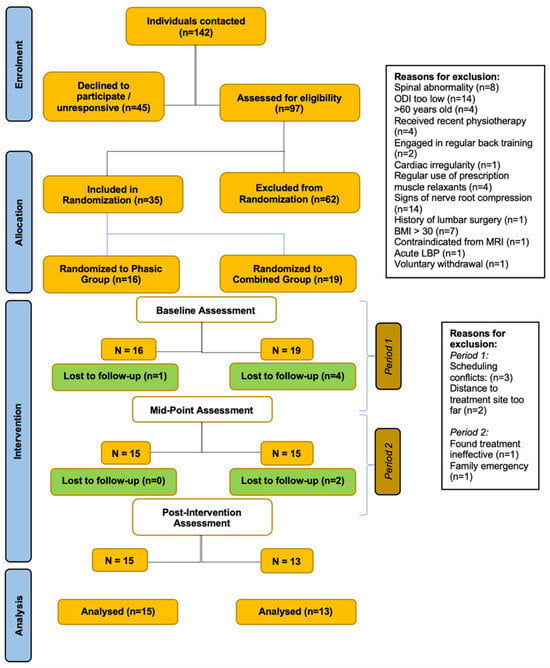
Figure 1
Open AccessCase Report
Morphological and Motor Ability Adaptations Following a Short-Term Moderate-Intensity Strength Training Intervention in a Sedentary Adult Male with Asymmetrical Bilateral Spastic Cerebral Palsy: A Case Study
by
Aleksandra Popović, Marko Kapeleti, Igor Zlatović, Milica Jankucić, Anastasija Kocić, Vladimir Mrdaković and Marija Macura
J. Funct. Morphol. Kinesiol. 2025, 10(4), 442; https://doi.org/10.3390/jfmk10040442 - 17 Nov 2025
Abstract
Background: Cerebral palsy (CP) is a group of permanent disorders affecting movement, posture, and balance. Spasticity is the most common movement disorder in CP, and muscle weakness is its primary impairment. There is a lack of studies that have examined the effects
[...] Read more.
Background: Cerebral palsy (CP) is a group of permanent disorders affecting movement, posture, and balance. Spasticity is the most common movement disorder in CP, and muscle weakness is its primary impairment. There is a lack of studies that have examined the effects of short-term, moderate-intensity strength training (ST) in adults with CP, whereas recommendations suggest that long-term interventions are necessary for substantial improvements in strength in the CP population. This study investigated the effects of a 5-week, moderate-intensity ST intervention, that targets various upper and lower extremity muscles, on multiple morphological characteristics (MC) and motor abilities (MA) in a sedentary 30-year-old adult male with asymmetrical bilateral spastic CP level II. Methods: Body composition, maximal knee strength, maximal squat strength, leg explosive strength, and hip mobility were assessed before and after the ST intervention. Results: Changes in body composition were modest (0.6–6.4%). Maximal knee strength increased moderately on the less spastic side (40.7–65.9%) and substantially on the more spastic side (118.5–130.6%). Hip mobility showed a similar pattern, with small to moderate improvements (11.4–30.0%), while maximal squat strength and leg explosive strength increased moderately (29.5–46.3%). Conclusions: A short-term, moderate-intensity ST intervention produced meaningful improvements in MC and MA in this subject, especially on the more spastic side. The applied ST program was feasible and potentially efficient, and the results of this single-case study support its approach and methodology in necessary future studies on larger trials in an attempt to generalize these preliminary findings. This in turn may encourage practitioners to promote increased participation in physical activity among individuals with CP, given the short-term period of adaptations. The study discusses the potential of further refinement of the existing CP-specific ST guidelines and load programming aspects.
Full article
(This article belongs to the Special Issue Innovative Physiotherapy Approaches and Functional Outcomes in Neurological and Developmental Disorders)
►▼
Show Figures
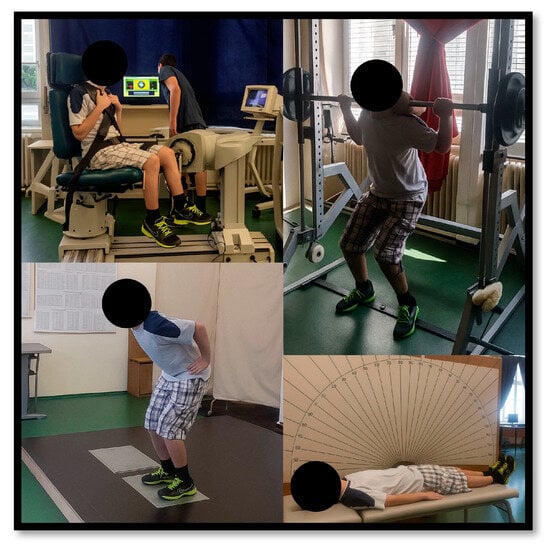
Figure 1
Open AccessReview
Functional Biomarkers Associated with Risk of Low Back Pain in Firefighters: A Systematic Review
by
John M. Mayer, Mina Botros, Elizabeth Grace and Ram Haddas
J. Funct. Morphol. Kinesiol. 2025, 10(4), 441; https://doi.org/10.3390/jfmk10040441 - 14 Nov 2025
Abstract
Background: Firefighters are at elevated risk of low back pain (LBP), yet predictors, mechanisms, and interventions for LBP in this occupation remain poorly defined. The purpose of this study was to systematically review the literature and synthesize the evidence on functional biomarkers associated
[...] Read more.
Background: Firefighters are at elevated risk of low back pain (LBP), yet predictors, mechanisms, and interventions for LBP in this occupation remain poorly defined. The purpose of this study was to systematically review the literature and synthesize the evidence on functional biomarkers associated with the risk of LBP in firefighters. Methods: PubMed, EMBASE, CINAHL, and PEDro were searched for studies evaluating functional biomarkers in firefighters with or without LBP, including aerobic capacity, anthropometric measures, disability/kinesiophobia, functional work tasks/capacity, imaging/structural/morphological characteristics, kinematics, movement quality/range of motion, muscular fitness, overall physical fitness, physical activity. Empirical evidence statements were generated for each biomarker domain, under Protocol Registration PROSPERO (CRD420251010061). Results: Eighteen studies (n = 32,977) met inclusion criteria and were predominantly cross-sectional (14/18) with fair quality (13/18), which suggests a substantial risk of bias. Higher disability/kinesiophobia and poorer functional work task performance were linked to increased risk of LBP, although causal relationships cannot be determined. Associations for the eight other biomarkers were inconsistent. Two interventional studies demonstrated benefits from trunk-focused exercise. Conclusions: The literature examining functional biomarkers and LBP in firefighters is fragmented, which precludes making robust and broad clinical recommendations for evidence-based implementation. Findings of future research may ultimately lead to approaches to improve the safety and health of firefighters with LBP through patient-centered and tailored programs addressing integrated functional biomarkers across the continuum of prevention, clinical care, and resilience development.
Full article
(This article belongs to the Section Functional Anatomy and Musculoskeletal System)
►▼
Show Figures
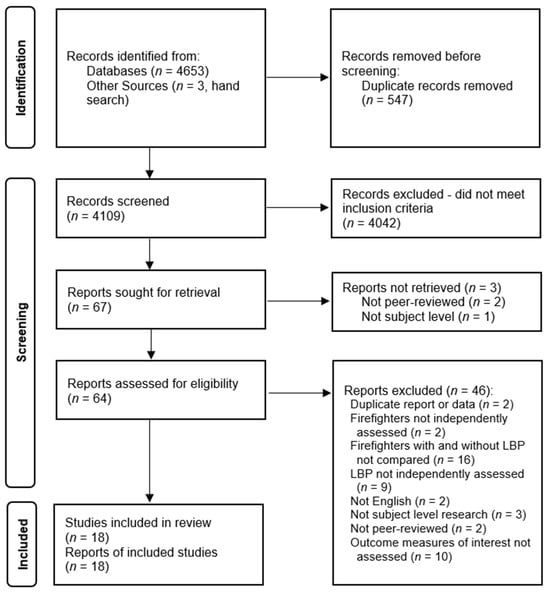
Figure 1
Open AccessArticle
Full Squats Enhance Performance and Body Composition, but Not Hypertrophy, Compared to Half Squats in Elite Young Tennis Players
by
Raouf Hammami, Agustín Jerez-Martínez, Pablo Jiménez-Martínez, Carlos Alix-Fages, Haithem Rebai, Oussema Kassis, Álvaro Juesas, Carlos Balsalobre-Fernández, Juan C. Colado and Javier Gene-Morales
J. Funct. Morphol. Kinesiol. 2025, 10(4), 440; https://doi.org/10.3390/jfmk10040440 - 13 Nov 2025
Abstract
Background: The aim was to compare the effects of full squat (FST) versus half squat training (HST) on body composition, muscle hypertrophy, and mean propulsive velocity (MPV) in young athletes. Methods: Twenty-eight highly trained male tennis players (13.88 ± 0.91 years,
[...] Read more.
Background: The aim was to compare the effects of full squat (FST) versus half squat training (HST) on body composition, muscle hypertrophy, and mean propulsive velocity (MPV) in young athletes. Methods: Twenty-eight highly trained male tennis players (13.88 ± 0.91 years, 166.08 ± 11.30 cm, 57.40 ± 8.99 kg, 14.34 ± 2.75% body fat) were randomly allocated to an eight-week FST or HST program. Training volume load was matched between interventions, and the only difference was the range of motion (squat depth). Pre- and post-training tests evaluated body composition (body mass and body fat percent), muscle hypertrophy (muscle volume of the thigh, calf, and leg, and cross-sectional area at half and maximum circumference of the thigh), and MPV at 45 and 50% of one-repetition maximum (1RM). An analysis of variance was used to analyze differences. Results: The results exhibited significant group-by-time interactions for body mass (p = 0.002, ηp2 = 0.32), body fat (p < 0.001, ηp2 = 0.71), and MPV (all p ≤ 0.005, ηp2 ≥ 0.27). Post hoc comparisons showed that both groups presented significant improvements in body composition, muscle hypertrophy, and MPV (all p ≤ 0.004). However, FST outperformed HST in body fat (p = 0.032) and MPV at both %1RM (p < 0.001). Conclusions: Overall, FST would be preferred over HST for tennis training in youth athletes. Four to five sets of 8–12 repetitions at 60–70% 1RM, two days a week during preseason, appear to be sufficient to induce neuromuscular performance improvement and enhance body composition.
Full article
(This article belongs to the Section Athletic Training and Human Performance)
►▼
Show Figures

Figure 1
Open AccessArticle
Dose–Response Effects of High-Intensity Interval Training on Body Fat, Blood Pressure, and Cardiorespiratory Fitness in Adolescents: A School-Based Randomized Controlled Trial with Responder Analysis
by
Jarosław Domaradzki, Eugenia Murawska-Ciałowicz, Marek Popowczak, Katarzyna Kochan-Jacheć, Paweł Szkudlarek and Dawid Koźlenia
J. Funct. Morphol. Kinesiol. 2025, 10(4), 439; https://doi.org/10.3390/jfmk10040439 - 13 Nov 2025
Abstract
Background: High-intensity interval training (HIIT) is effective for improving body composition and cardiorespiratory fitness, but individual variability in responsiveness remains a challenge. This study examined the dose–response effects of three HIIT session durations (6, 8, and 10 min) and whether previously non-responsive
[...] Read more.
Background: High-intensity interval training (HIIT) is effective for improving body composition and cardiorespiratory fitness, but individual variability in responsiveness remains a challenge. This study examined the dose–response effects of three HIIT session durations (6, 8, and 10 min) and whether previously non-responsive adolescents could benefit from a modified program. Methods: A total of 137 adolescents completed one of three school-based HIIT interventions. Body fat percentage (BF%), systolic and diastolic blood pressure, and maximal oxygen uptake (VO2max) were assessed before and after the intervention. Responders and non-responders were classified using a Bayesian approach. Statistical analyses included ANOVA, McNemar’s test, logistic regression, and generalized estimating equations. Results: All protocols improved outcomes, with the 10 min sessions producing the most consistent VO2max gains. No significant differences were observed for BF% or blood pressure. Individual analysis showed that more than half of the participants responded positively to training, depending on the outcome. Among prior non-responders, 70–100% showed improvements after the modified intervention. The number of previously non-responsive outcomes strongly predicted improvement (Odds Ratio > 2.4, p < 0.01). Conclusions: School-based HIIT can induce meaningful adaptations even in previously non-responsive adolescents. Individualized monitoring and adjustment of training dose may optimize responsiveness and support health promotion in youth.
Full article
(This article belongs to the Section Physical Exercise for Health Promotion)
►▼
Show Figures

Figure 1
Open AccessArticle
The Role of Toss Zenith and Impact Height in the Relationship Between Shoulder Rotation Strength and Serve Speed in Junior Tennis Players
by
Jan Vacek, Michal Vagner, Jan Malecek, Jachym Simsa, Vladan Olah and Petr Stastny
J. Funct. Morphol. Kinesiol. 2025, 10(4), 438; https://doi.org/10.3390/jfmk10040438 - 10 Nov 2025
Abstract
Background: Serve speed in tennis can be influenced by physical strength and toss kinematics, yet their interaction remains unclear in junior athletes. This study investigated the relationships between toss-related variables (zenith height, impact height, and zenith–impact differential), shoulder rotation strength, and serve speed
[...] Read more.
Background: Serve speed in tennis can be influenced by physical strength and toss kinematics, yet their interaction remains unclear in junior athletes. This study investigated the relationships between toss-related variables (zenith height, impact height, and zenith–impact differential), shoulder rotation strength, and serve speed in junior tennis players. Methods: Thirteen nationally ranked junior male players (mean age: 15.8 ± 0.9 years; body mass: 65.9 ± 5 kg; height: 181 ± 7 cm) participated. Isokinetic shoulder internal and external rotation strength (concentric/eccentric at 210°/s and 300°/s) were measured. High-speed 3D motion capture (Qualisys) recorded toss zenith, impact height and zenith–impact differential during flat serves directed into a designated 1 × 2 m target zone. Serve speed was measured by a radar gun. Correlation, mediation, and moderation analyses were conducted (n = 13; sensitivity ρ ≥ 0.69 for 80% power). Results: Impact height showed a significant positive correlation with successful (ρ = 0.746, p = 0.003) and unsuccessful serve speed (ρ = 0.776, p = 0.002). Moderation analyses showed that lower variability in impact height (p = 0.043) and in zenith–impact differential (p = 0.048) significantly strengthened the association between shoulder-rotator strength and serve speed. Conclusions: Moderation analyses revealed that lower variability in impact height and in the zenith–impact differential strengthened the relationship between shoulder strength and serve speed. Preliminary evidence suggests that consistent toss execution could enhance the translation of shoulder-rotation strength into serve speed in junior players.
Full article
(This article belongs to the Special Issue Optimizing Performance: Training Strategies to Improve Strength, Speed, Power, and Endurance)
►▼
Show Figures

Figure 1
Open AccessReview
The Evaluation of Physical Performance in Rowing Ergometer: A Systematic Review
by
Iñigo Borges, Santiago Veiga and Pablo González-Frutos
J. Funct. Morphol. Kinesiol. 2025, 10(4), 437; https://doi.org/10.3390/jfmk10040437 - 9 Nov 2025
Abstract
Background: Growing interest in optimizing rowing performance has led to numerous ergometer-based testing protocols. However, this diversity has created a lack of consensus on which physiological variables best predict rowing performance. This systematic review provides an updated synthesis of the main ergometer
[...] Read more.
Background: Growing interest in optimizing rowing performance has led to numerous ergometer-based testing protocols. However, this diversity has created a lack of consensus on which physiological variables best predict rowing performance. This systematic review provides an updated synthesis of the main ergometer testing protocols and identifies the variables most strongly associated with 2000 m performance. Methods: A systematic search was conducted across PubMed, Web of Science, and Scopus databases, following PRISMA and STROBE guidelines. Studies were selected based on predefined inclusion criteria, and methodological quality was assessed accordingly (PROSPERO: CRD420251027702). Results: Thirty-four studies comprising 909 rowers (657 men, 252 women) across elite (20%), sub-elite (32%), and recreational (47%) levels were analyzed. The 2000 m test was the most frequently employed protocol (79%), followed by incremental (INCR) tests. The 2000 m test reflects competition performance, whereas INCR tests are primarily used to assess VO2max and PPO, the variables most strongly correlated with 2000 m outcomes. Power at lactate threshold and CP also showed strong associations with performance, particularly when measured through short, time-efficient protocols that minimize fatigue. Conclusions: The strongest and most consistent correlates of 2000 m ergometer performance are VO2max and PPO (r = 0.83–0.99). CP is likewise strongly associated (n = 4 studies) but rests on a smaller evidence base. Given that 72% of the analyzed sample comprised male participants, extrapolation of these findings to female rowers warrants caution.
Full article
(This article belongs to the Section Athletic Training and Human Performance)
►▼
Show Figures
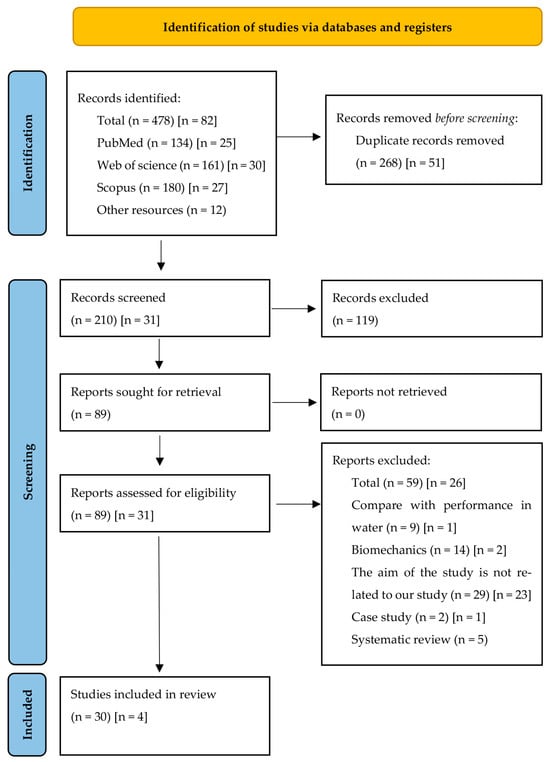
Figure 1
Open AccessBrief Report
The Dynamic Change in the Neutrophil–Lymphocyte Ratio and Systemic Inflammatory Response Index After Undergoing an Intensive Resistance-Based Exercise Program
by
Timothy P. Dougherty, David J. Carpenter, Chris Peluso and Colin E. Champ
J. Funct. Morphol. Kinesiol. 2025, 10(4), 436; https://doi.org/10.3390/jfmk10040436 - 8 Nov 2025
Abstract
Background: The change over time of certain inflammatory markers, such as the neutrophil–lymphocyte ratio (NLR) and systemic inflammatory response index (SIRI), is a prognostic factor in many cancers, including breast cancer. This study retrospectively evaluated how a 12-week intensive exercise program might have
[...] Read more.
Background: The change over time of certain inflammatory markers, such as the neutrophil–lymphocyte ratio (NLR) and systemic inflammatory response index (SIRI), is a prognostic factor in many cancers, including breast cancer. This study retrospectively evaluated how a 12-week intensive exercise program might have influenced both the NLR and SIRI in women with breast cancer. Methods: Two institutional review board-approved prospective clinical trials, EXERT-BC (NCT05747209, 2 November 2022) and EXERT-BCN (NCT05978960, 31 July 2023), were retrospectively assessed. Complete blood count (CBC) values performed before and after participation in a 12-week intensive resistance program were analyzed post hoc. Blood tests were ordered as part of routine clinical care and not pre-specified by either study protocol. Participants who had blood work more than four months from study intake or completion were excluded. Additionally, those undergoing active systemic therapy or with underlying inflammatory conditions were also excluded. The NLR and SIRI values were analyzed via the Mann–Whitney test, with pair-wise assessment of pre- and post-intervention values via the Wilcoxon signed-rank test. Results: Out of 84 participants, 21 people met the inclusion criteria. Roughly 70% had either ductal carcinoma in situ (DCIS) or early-stage breast cancer. The average blood draw was taken within two months of study intake and outtake. After the 12-week structured exercise program, there was an associated reduction in both the NLR (2.26 [IQR, 1.70–4.22] to 1.99 [1.44–2.62]; ΔNLR = −0.27, W = 47.0, p = 0.016) and SIRI (1.23 [0.82–1.64] to 0.80 [0.59–1.45]; ΔSIRI = −0.43, W = 48.0, p = 0.018). Of those who saw their inflammatory markers improve, roughly two thirds showed a clinically relevant improvement. Conclusions: Completion of a 12-week intensive resistance exercise program was associated with a statistically improved NLR and SIRI. The small sample size and retrospective nature limit the broader application of these findings. The results, however, provide a genesis for prospective validation examining the potential benefit exercise might have on the NLR and SIRI in women with breast cancer.
Full article
(This article belongs to the Section Sports Medicine and Nutrition)
►▼
Show Figures

Figure 1
Open AccessArticle
The Acute Effects of Internal, External, and Golf-Specific Attentional Focus Cues on Isometric Trunk Strength in Youth Golfers
by
Raouf Hammami, Achraf Hammami, Yassine Negra, Rimeh Staff, Jason Moran and Roland van den Tillaar
J. Funct. Morphol. Kinesiol. 2025, 10(4), 435; https://doi.org/10.3390/jfmk10040435 - 7 Nov 2025
Abstract
Background: Attentional focus strategies, including internal, external, and sport-specific cues, can influence muscle strength by modulating motor control. However, their acute effects on maximal isometric back-extensor strength in youth athletes under controlled laboratory conditions remain unclear. Methods: Fourteen youth golfers (15.8
[...] Read more.
Background: Attentional focus strategies, including internal, external, and sport-specific cues, can influence muscle strength by modulating motor control. However, their acute effects on maximal isometric back-extensor strength in youth athletes under controlled laboratory conditions remain unclear. Methods: Fourteen youth golfers (15.8 ± 0.5 years) performed maximal voluntary isometric back-extension tasks under nine cueing conditions: three internal, three external, and three golf-specific. The task involved exerting maximal force against a fixed, immovable resistance while maintaining standardized trunk and hip positions to ensure consistent execution. Cueing was delivered verbally in a standardized manner across participants and sessions. Maximal isometric strength was compared across conditions using repeated-measures analyses. Results: Maximal isometric back-extensor strength was significantly (p = 0.004 ηp2 = 0.34) lower with internal cues (57.1 ± 16.0 kg) compared with external (68.2 ± 13.0 kg) and golf-specific (68.1 ± 12.5 kg) cues. Specifically, the internal cues ‘engage your glutes and hamstrings’, ‘tighten your core’, and ‘maintain a neutral spine’ produced lower force than all external cues and the golf-specific cue ‘focus on using your lower body to create a stable base for your golf swing’. Among internal cues, ‘engage your glutes and hamstrings’ resulted in the lowest torque. Conclusions: External and certain golf-specific verbal cues acutely enhance maximal isometric back-extensor force more effectively than internal cues in a controlled laboratory setting. While these results inform how attentional focus can modulate acute force output in youth athletes, the task does not replicate the dynamic, rotational nature of the golf swing, and the findings should not be interpreted as direct indicators of golf performance. Future research should explore long-term adaptations and assess transfer to sport-specific, dynamic movements.
Full article
(This article belongs to the Special Issue Optimizing Performance: Training Strategies to Improve Strength, Speed, Power, and Endurance)
►▼
Show Figures

Figure 1
Open AccessArticle
Uncovering the Latent Components of Physical Performance in Professional Soccer: Evidence from the Turkish First Division
by
Spyridon Plakias, Dimitris Tsaopoulos, Themistoklis Tsatalas and Giannis Giakas
J. Funct. Morphol. Kinesiol. 2025, 10(4), 434; https://doi.org/10.3390/jfmk10040434 - 7 Nov 2025
Abstract
Background: Physical performance in soccer is usually described through isolated indicators such as total distance or sprint frequency, which may overlook the broader structure of match demands. Purpose: This study aimed to identify the latent components of physical performance in professional soccer and
[...] Read more.
Background: Physical performance in soccer is usually described through isolated indicators such as total distance or sprint frequency, which may overlook the broader structure of match demands. Purpose: This study aimed to identify the latent components of physical performance in professional soccer and to examine how they vary across playing positions. Methods: External load data were collected from 446 outfield players competing in the Turkish first division during the 2021–2022 season, using optical tracking technology. Distances covered at different speed thresholds and maximal speed were analyzed through principal component analysis. Factor scores were compared across positions using non-parametric tests. Results: Three components of physical performance emerged: (1) moderate-intensity running (2–5.5 m/s, inverse to low-speed activity), (2) high-intensity running (>5.5 m/s), and (3) sprint capacity (maximal speed). Central midfielders recorded the highest values in moderate-intensity running, wingers and wing backs excelled in high-intensity running, while sprint capacity was most strongly associated with wingers. Conclusions: The findings provide a more integrated understanding of soccer’s physical demands, moving beyond single indicators to reveal broader performance dimensions. This framework can support coaches, analysts, and scouts in player profiling, training design, and rehabilitation planning, while emphasizing the need for position-specific physical preparation.
Full article
(This article belongs to the Special Issue Integrative Perspectives on Functional Morphology, Performance and Injury Prevention in Soccer)
►▼
Show Figures

Figure 1
Open AccessArticle
Effects of Pilates Matwork Core Exercises on Functioning in Middle-Aged Adult Women with Chronic Nonspecific Low Back Pain Through Flexion Relaxation Phenomenon Analysis: A Pilot RCT
by
Nicola Marotta, Alessandro de Sire, Federica Pisani, Michele Mercurio, Ennio Lopresti, Lorenzo Scozzafava, Andrea Parente, Giorgio Gasparini, Umile Giuseppe Longo and Antonio Ammendolia
J. Funct. Morphol. Kinesiol. 2025, 10(4), 433; https://doi.org/10.3390/jfmk10040433 - 6 Nov 2025
Abstract
Objectives: Pilates is frequently recommended for patients with Chronic Nonspecific Low Back Pain (CNLBP) due to its potential to enhance posture, muscle strength, trunk flexibility, and stability. However, to date, there is no robust evidence supporting the effectiveness of Pilates in managing
[...] Read more.
Objectives: Pilates is frequently recommended for patients with Chronic Nonspecific Low Back Pain (CNLBP) due to its potential to enhance posture, muscle strength, trunk flexibility, and stability. However, to date, there is no robust evidence supporting the effectiveness of Pilates in managing CNLBP. This study aimed to assess the effects of 8 × 8 Pilates Matwork core exercises on pain and functioning in middle-aged adult women with CNLBP, through a flexion relaxation phenomenon (FRP) analysis. Methods: We included middle adult women (n = 21) with diagnosis of CNLBP and a Numeric Rating Scale (NRS) > 4. The experimental group underwent a treatment of eight Pilates Matwork sessions, biweekly for 4 weeks, lasting about 40 min. The control group underwent standardized exercises used for managing CNLBP. Outcome measures included NRS, Oswestry Disability Index (ODI), Quebec Back Pain Disability Scale (QBPDS), and the FRP ratio via surface electromyography during trunk maximum flexion. We evaluated the participants at the baseline (T0), at the end of the 4-week treatment (T1), and at 4 weeks after the end of the treatment, at 8 weeks from the baseline (T2). Results: In this pilot RCT, 21 middle-aged adult women affected by CNLBP were randomly allocated with a ratio of 1:1 in the Pilates group, and in parallel in the control group. The experimental group showed a significant improvement in ODI and QBPDS scores compared to the control group, maintained at follow-up for ODI, along with an NRS reduction at T2. About FRP, Pilates has proven to be comparable to conventional treatment, showing no significant difference in FRR at T1 and T2. Only the experimental group exceeded the 9.5 cutoff at T2, as a protective predictive index for CNLBP. Conclusions: This pilot RCT provided preliminary evidence that Pilates might be an effective rehabilitation method, enhancing functioning and pain management in middle-aged adult women affected by CNLBP. The FRP study proves to be efficient in translating clinical assessments into rehabilitation assessment measures.
Full article
(This article belongs to the Special Issue Biomechanical Analysis in Physical Activity and Sports—2nd Edition)
►▼
Show Figures

Figure 1
Open AccessArticle
The Muscle-Bone Unit in Male Elite Soccer Players Aged 14–19
by
Valentina Cavedon, Carlo Zancanaro and Chiara Milanese
J. Funct. Morphol. Kinesiol. 2025, 10(4), 432; https://doi.org/10.3390/jfmk10040432 - 5 Nov 2025
Abstract
Background: Muscle and bone show reciprocal interactions and are associated in a muscle-bone unit. The muscle-bone unit has been investigated to a very limited extent in soccer players. The objective of this work was to investigate in detail the muscle-bone unit in
[...] Read more.
Background: Muscle and bone show reciprocal interactions and are associated in a muscle-bone unit. The muscle-bone unit has been investigated to a very limited extent in soccer players. The objective of this work was to investigate in detail the muscle-bone unit in male youth elite soccer players. Methods: Bone mineral and lean mass were measured with dual-energy X-ray absorptiometry (DXA). The functional muscle-bone unit (fMBU) and the muscle-to-bone ratio (MBR) were calculated from the DXA output in a sample of players aged 14–19 (n = 193) playing in the youth squads of an Italian Serie A team. Results: Statistically significant (p < 0.05) correlations were found between lean mass variables and bone mineral content and density, also after adjusting for age, body mass, stature, maturity, and ethnicity (White/Black). fMBU and MBR were statistically significantly associated with age, body mass, stature, maturity, and ethnicity. Linear regression showed that body lean mass was the strongest predictor for bone mineral content and density. Age was a statistically significant predictor for fMBU and MBR. Playing position did not show any statistically significant relationship with bone mineral content and density, as well as fMBU or MBR. Centiles for fMBU and MBR were calculated as a reference. Conclusions: This work is the first detailed characterization of the muscle-to-bone relationship in soccer players. It is expected to be of use for sport scientists and the wide community of sportsmen and professionals involved in soccer.
Full article
(This article belongs to the Special Issue Body Composition Assessment: Methods, Validity, and Applications)
►▼
Show Figures

Figure 1
Open AccessArticle
Direct Versus Indirect Submaximal VO2max Assessment in Masters Basketball Players
by
Kristine Dakule, Una Veseta, Voldemars Arnis, Ketija Grinberga, Oskars Kalejs and Signe Tomsone
J. Funct. Morphol. Kinesiol. 2025, 10(4), 431; https://doi.org/10.3390/jfmk10040431 - 5 Nov 2025
Abstract
Background: Accurate assessment of aerobic capacity is essential for performance monitoring in masters athletes, particularly in high-intensity team sports. The objective of this study was to evaluate the validity and agreement of three indirect maximal oxygen uptake (VO2max) protocols (Åstrand–Ryhming, YMCA,
[...] Read more.
Background: Accurate assessment of aerobic capacity is essential for performance monitoring in masters athletes, particularly in high-intensity team sports. The objective of this study was to evaluate the validity and agreement of three indirect maximal oxygen uptake (VO2max) protocols (Åstrand–Ryhming, YMCA, and Polar OwnIndex Fitness test) against the gold-standard cardiopulmonary exercise testing (CPET) in masters basketball players. Methods: A cross-sectional comparative study included 50 male masters basketball players (aged 51–81 years, M = 64.3 ± 7.9). Validity was determined by comparing results from the three indirect protocols to direct VO2max measurement via CPET. Agreement was assessed using Pearson correlations (r), systematic error, mean absolute error (MAE), and Bland–Altman limits of agreement. Results: The Åstrand–Ryhming test and YMCA tests showed the closest agreement with CPET (systematic error < 4%, MAE ≈ 17–18%, r > 0.50). The Polar OwnIndex test substantially overestimated VO2max (mean error ≈ 30%, MAE = 32%). The Åstrand–Ryhming test at low workload yielded the strongest correlation (r = 0.75). Conclusions: The Åstrand–Ryhming and YMCA submaximal tests demonstrated acceptable validity and low systematic bias for estimating VO2max in masters basketball players, positioning them as practical alternatives to CPET. Conversely, the Polar OwnIndex test showed poor agreement and clinically significant overestimation. These findings support the use of submaximal cycling protocols for fitness monitoring and tailored training prescription in this specific older athlete population. Future longitudinal research is warranted to confirm their ability to track fitness changes over time in this population.
Full article
(This article belongs to the Special Issue Applied Sport Physiology and Performance—4th Edition)
►▼
Show Figures

Figure 1
Highly Accessed Articles
Latest Books
E-Mail Alert
News
Topics
Topic in
Applied Sciences, JFMK, Sports, Children
Movement and Health: Holistic Development to Support Long-Term Active Lifestyles
Topic Editors: Francesco Sgrò, David StoddenDeadline: 31 December 2025
Topic in
Biomechanics, JFMK, Sports
Concurrent Strength and Endurance Training
Topic Editors: Alejandro Pérez-Castilla, Manuel A. Rodríguez PérezDeadline: 28 February 2026
Topic in
JFMK, Medicina, Therapeutics, Healthcare, JCM, Rheumato
New Trends in Physiotherapy Care: Improvements in Functionality, Pain Management, and Quality of Life
Topic Editors: Carlos Bernal-Utrera, Ernesto Anarte-Lazo, Juan José González GerezDeadline: 3 March 2026
Topic in
Antioxidants, IJMS, JFMK, Life, Physiologia
Skeletal Muscle Adaptations to Oxidative Stress
Topic Editors: Guglielmo Duranti, Zsolt RadakDeadline: 30 April 2026

Special Issues
Special Issue in
JFMK
Physical Training in Hypoxia: Physiological Changes and Performance
Guest Editor: Víctor Toro-RománDeadline: 30 November 2025
Special Issue in
JFMK
Advances in Physiology of Training—2nd Edition
Guest Editor: Christopher BallmannDeadline: 30 November 2025
Special Issue in
JFMK
Tactical Athlete Health and Performance
Guest Editor: Angelia Maleah Holland-WinklerDeadline: 30 November 2025
Special Issue in
JFMK
Optimizing Post-Activation Performance Enhancement: 2nd Edition
Guest Editor: Michał KrzysztofikDeadline: 30 November 2025
Topical Collections
Topical Collection in
JFMK
Feature Papers in Journal of Functional Morphology and KinesiologyCollection Editor: Giuseppe Musumeci



